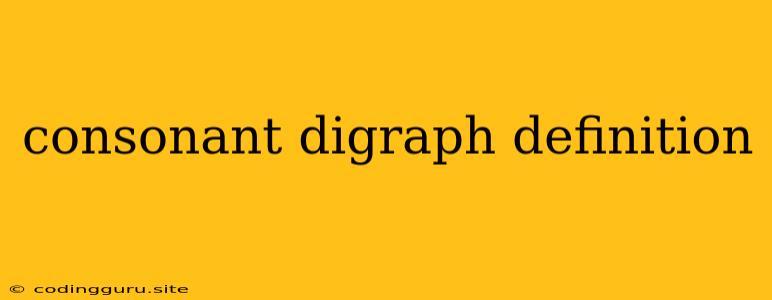What is a Consonant Digraph?
A consonant digraph is a combination of two letters that represent a single consonant sound. These digraphs are common in the English language, and they can sometimes be tricky for learners to master. Let's delve deeper into the world of consonant digraphs, exploring their definition, examples, and how they contribute to the complexities of the English language.
Understanding the Concept
Imagine you're trying to decipher a code, and two letters together represent a single secret symbol. This is what a consonant digraph is like – two letters working together to form a single sound.
Here's a simple breakdown:
- Digraph: The word "digraph" itself implies a "two-letter" combination.
- Consonant: The letters in this combination are consonants, not vowels.
- Sound: The key point is that these two letters create a single consonant sound, not two separate sounds.
Common Examples of Consonant Digraphs
Let's take a look at some frequently encountered consonant digraphs in English:
- "sh" as in "ship", "shoe", "fish"
- "ch" as in "chair", "church", "match"
- "th" as in "thin", "think", "father"
- "wh" as in "what", "when", "where"
- "ph" as in "phone", "graph", "elephant"
These are just a few examples; there are many other consonant digraphs in English, and they can be found in a wide variety of words.
Understanding the Sound
The sound produced by a consonant digraph can sometimes differ from the sounds of the individual letters. For example, the "ch" digraph in "chair" does not sound like the "c" in "cat" or the "h" in "hat." It represents a unique sound.
Similarly, the "th" digraph can represent two distinct sounds:
- "th" as in "thin" (a voiceless "th" sound)
- "th" as in "this" (a voiced "th" sound)
This distinction between voiced and voiceless sounds is important for understanding how consonant digraphs function in the English language.
How Consonant Digraphs Impact Language
Consonant digraphs play a significant role in the English language, influencing pronunciation, spelling, and even the complexity of the language itself.
Here's how:
- Pronunciation: Consonant digraphs introduce a layer of complexity to pronunciation, making English more challenging for learners.
- Spelling: Consonant digraphs are essential for accurate spelling. They contribute to the irregularity of English spelling, where the sound of a word doesn't always directly correspond to its letters.
- Richness: Consonant digraphs add a layer of complexity and nuance to the English language, allowing for a wider range of sounds and expressions.
Tips for Learners
If you're struggling to master consonant digraphs, here are some tips:
- Focus on sound: Pay attention to the sound produced by the digraph, not just the individual letters.
- Practice: Read aloud words with consonant digraphs and practice writing them.
- Look for patterns: There are some common patterns associated with consonant digraphs. For example, the "sh" sound is often spelled "sh" at the end of words.
- Use mnemonic devices: Create fun memory aids to help you remember the sound of different consonant digraphs.
Conclusion
Consonant digraphs are an integral part of the English language, contributing to its richness and complexity. They challenge learners but also enhance the expressiveness of this multifaceted language. Understanding these digraphs, their sounds, and how they influence spelling is essential for mastering the intricacies of English.
